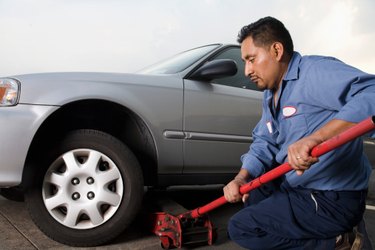Things You'll Need
Wheel chocks
Hydraulic floor jack

Hydraulic floor jacks can help lift automobiles and garden tractors, enabling you to work beneath the vehicle or to change tires. The physics involved in the operation of this type of jack are simple. Fluid pumps into a cylinder in small increments, which raises an actuator arm. Since it's difficult to compress fluids, the cylinder continues to provide a lifting effort until the arm extends completely or the pumping of fluid ceases. Adjusting a threaded saddle allows you to use the jack beyond the extension of the actuator arm.
Step 1
Place wheel chocks on either side of the vehicle wheels on the side opposite the one you are raising.
Video of the Day
Step 2
Place the shift lever in the "Park" position on automatic transmissions or first gear if the vehicle has a standard transmission. Set the emergency brake and remove the keys.
Step 3
Position the floor jack under the vehicle with the saddle aligned with a firm section of the frame.
Step 4
Adjust the jack saddle by turning it counterclockwise until you achieve the desired additional height. Hydraulic floor jack manufacturers may have saddles that adjust to different heights.
Step 5
Raise the floor jack and saddle by operating the pump handle up and down. Close the fluid bleed screw prior to operating the pump. Look for the bleed screw at the base of the jack hydraulic cylinder.
Step 6
Adjust the extension of the hydraulic floor jack by pumping fluid into the cylinder, which raises the load to the desired height.
Step 7
Adjust the bleed screw by turning it counterclockwise when lowering loads and tighten when raising. The bleed screw has a horizontal pin that fits into the base of the pump handle.
Tip
Use floor jacks on flat, firm surfaces only.
Use jack stands when working under vehicles.
Video of the Day